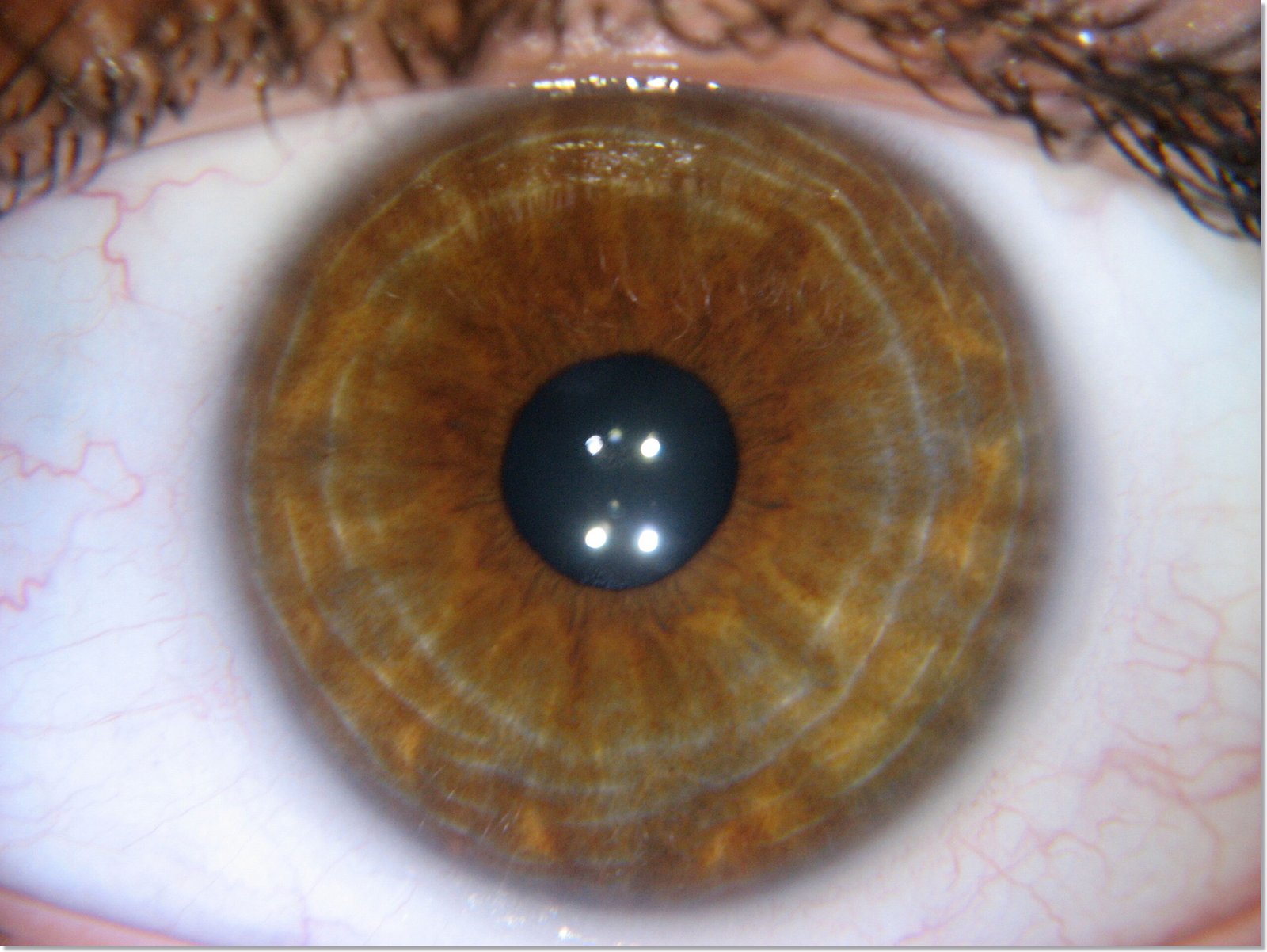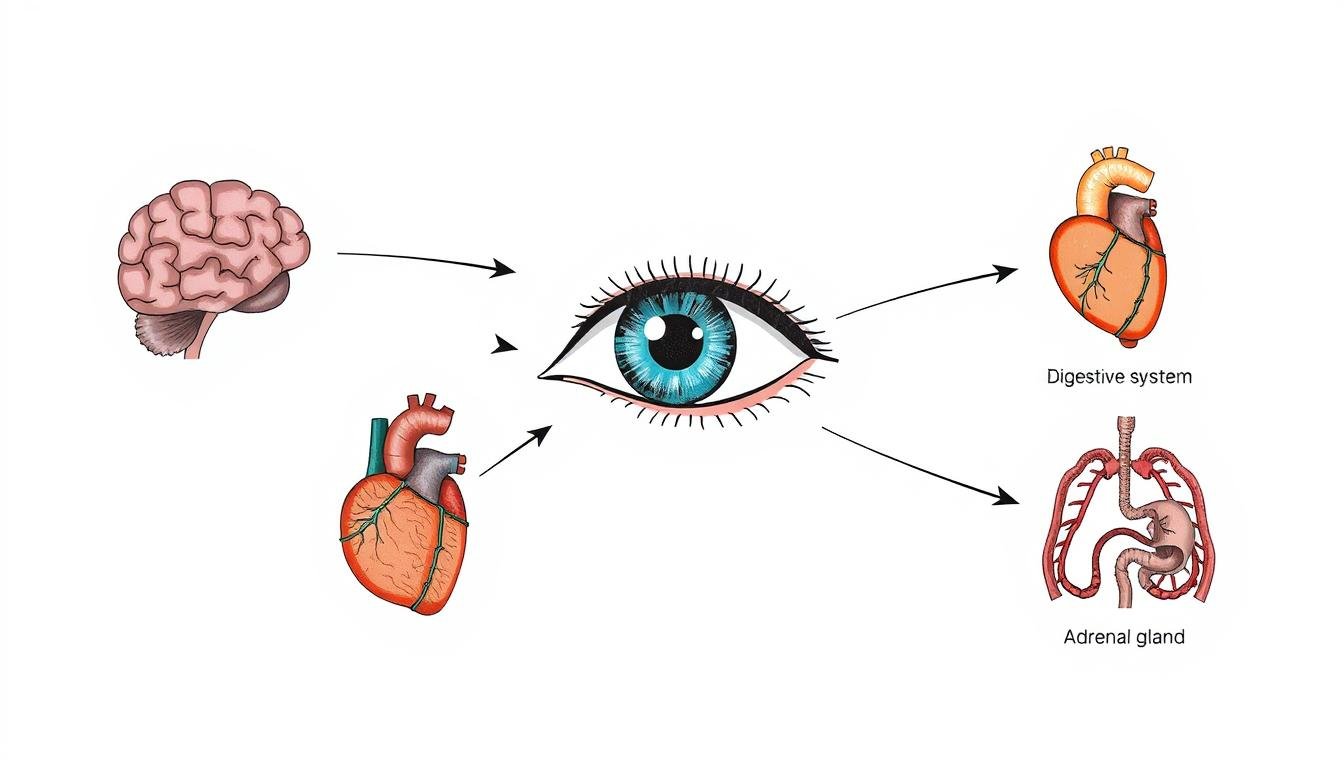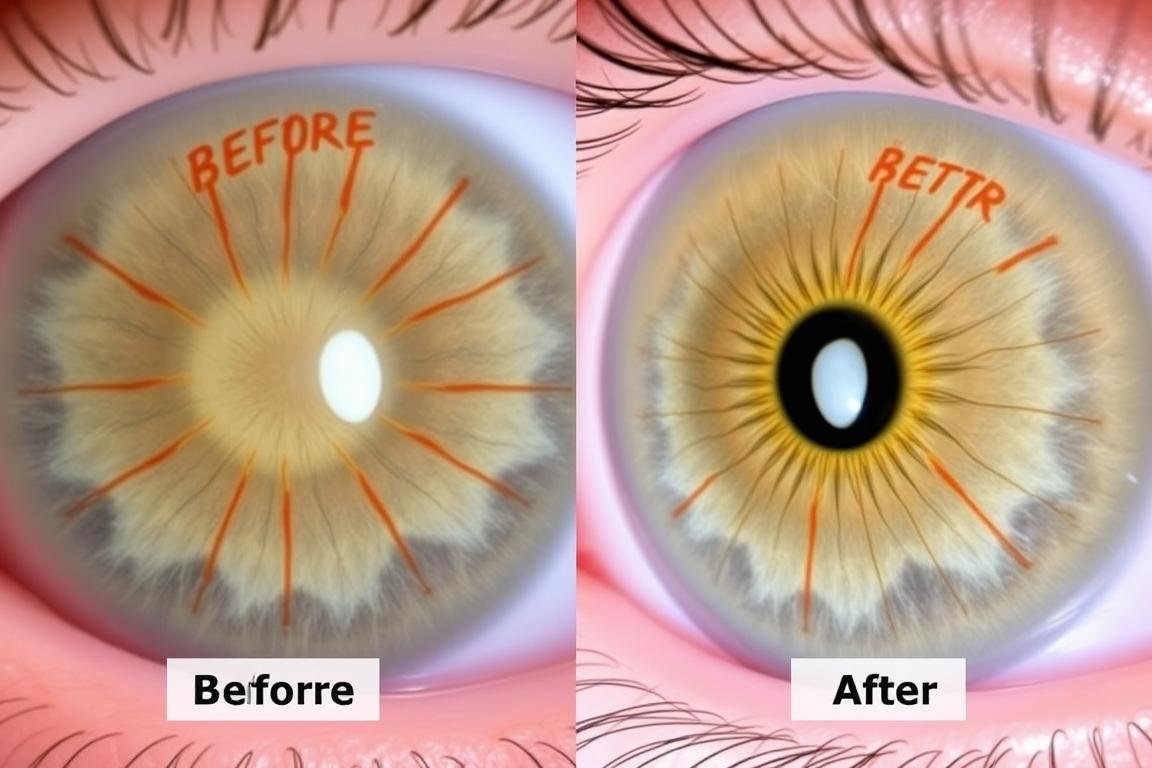اکين ۾ زور ڀرڻ، تاڪيدري يا اعصاب جي تارن يا اعصاب جي شڪلن کي پڻ سڃاتو وڃي ٿو، اهو جسم ۾ سرڪشي جو نمونو ظاهر ڪري ٿو جيڪو جسم ۾ جسماني يا جذباتي تڪرار ظاهر ٿئي ٿو. اهي ڪنٽرڪ حلقا نمبر ۽ شدت ۾ مختلف طور تي مختلف ٿي سگهن ٿا، ممڪن طور تي توهان جي مجموعي صحت ۽ دٻاء جي سطح بابت معلومات ظاهر ڪري سگهن ٿا. سمجھو ته اهي مخصوص نشانن جو سبب بڻجن ٿا ۽ انهن کي ڪيئن توهان جي اکين جي صحت ۽ عام ڀلائي لاء توهان کي ڪيترو به قابل قدر ٿي سگهي ٿو.

اکين ۾ دٻاء وجهي رهيا آهن؟
دٻاء واريون تارون آئيسس اسٽروما ۾ سرڪشي جي ڊپريشن يا اوندهه وانگر ظاهر ٿيون آهن. اهي ڪنٽرڪ حلقا شاگرد کان ٻاهر نڪرندا آهن ۽ نمبر، گہرائي ۽ نمائش ۾ مختلف ٿي سگهن ٿا. oridology ۾، متبادل دوا جو هڪ روپ جيڪو آريس جي نمونن جو مطالعو آهي، اهي انگن اکرن کي نروسڪوسڪولر ڪليسرز جي رنگن يا تفاوت جو حوالو ڏنو ويو آهي.
توهان جي آئيس رنگ تي منحصر آهي ته دٻاء جي رنگن جي شڪل مختلف ٿي سگهي ٿي. اهي عام طور تي لائٽر رنگين رنگن ۾ وڌيڪ ظاهر آهن جهڙوڪ نيرو، سائو، يا هزيل، جڏهن ته اهي خاص سامان کانسواء اونداهي اکين جي اکين ۾ ڳولڻ ۾ مشڪل ٿي سگهن ٿا.

اکين ۾ زور ڀرڻ، اهي حلقا عام طور تي غير معمولي مبصر ڏانهن ظاهر نه ٿيندا آهن ۽ عام طور تي اکين جي امتحان دوران يا اڻ وڻندڙ تشخيص دوران سڃاڻپ ڪيا ويندا آهن. جڏهن ته روايتي دوا تشخيص لاء IRIS جا حلقا استعمال نٿا ڪن، ڪجهه متبادل صحت جي مشق کي يقين ڏياريندو آهي ته اهي نشان هڪ شخص جي جسماني حالت ۾ بصيرت فراهم ڪن ٿا.
اکين ۾ زور ڀرڻ جو بنيادي سبب
آئيس ۾ دٻاء وجهڻ بي ترتيب طور تي ظاهر نه ٿيندا آهن. ڪيترائي عنصر انهن جي ترقي ۾ حصو ڏئي سگھن ٿا:
جسماني ۽ جذباتي دٻاء
پريشاني جي ڊگهي عرصي، پريشاني، يا جسماني دٻاء زور ڀرڻ لڳن ٿا. جسم جو دٻاء وارو جواب مختلف نظام تي اثرانداز ٿئي ٿو، انهن سميت جيڪي IRI جوڙجڪ تي اثر انداز ٿين ٿا. دائمي دٻاء جي دورن دوران، س legg ي جسم ۾ س round ي س round ي س round ي س round ي س rough ي عضلات سميت، بشمول انهن حلقن جي قيام ۾ مدد ڪري سگهي ٿي.
غذائيت جي گھٽتائي
ضروري معدنيات، خاص طور تي ڪيلشيم ۽ ميگنيشيم، دٻاء جي تارن جي ترقي ۾ حصو وٺي سگھي ٿو. اهي معدنيات اعصاب سسٽم جي فنڪشن ۽ عضلات جي آرام ۾ اهم ڪردار ادا ڪندا آهن. جڏهن گهٽتائي، جسم مختلف نشانين کي ظاهر ڪري سگھي ٿو، بشمول IRIS ظهور ۾ تبديليون شامل آهن.
جينياتي عنصر
شايد ڪجهه ماڻهن تي دٻاء واري رنگن کي ترقي ڏيڻ لاء جينياتي اڳڪٿي آهي. جيڪڏهن توهان جا والدين يا ويجها مائٽن جو مظمدار زور ڀريو ويندو آهي، توهان شايد انهن کي پڻ ترقي ڪري سگهو ٿا، خاص طور تي انهن کي ترقي يافته هوندا، خاص طور تي هڪجهڙا دٻاء وجهندا آهن.
دائمي ٿڪ ۽ غريب ننڊ
ناکافي آرام ۽ دائمي ٿڪ زور ڀرڻ جي شڪل ۾ حصو ڏئي سگهي ٿو. روزانو دٻاء مان وصولي لاء لاش جي مناسب ننڊ جي ضرورت آهي، ۽ جڏهن اها وصولي جو دور ٺهڪي اچي، اهو شايد مختلف طريقن سان ظاهر ٿئي ٿو.

اکين جي دٻاء واري رنگن سان جڙيل علامات کي سڃاڻڻ
جڏهن ته دٻاء پنهنجو پاڻ کي جسماني تڪليف سان گڏ نه هوندا آهن، اهي عام طور تي ٻين علامتن سان گڏ ظاهر ٿيندا آهن جيڪي گهٽ ۾ وڌايل صحت جا خدشا ظاهر ڪن ٿا:
عام علامتون جيڪي شايد دٻاء واري رنگن سان گڏ هجن
- بار بار سر درد، خاص طور تي تڪرار سر درد
- خشڪ، خارش اکيون يا روشنيء کي روشن ڪرڻ
- اونداهي حلقا يا اکين جي چوڌاري پف
- توجه جي وڌايل دورن کان پوء ويندڙ خواب
- عام ٿڪ ۽ توجه ڏيڻ ۾ مشڪل
- ننڊ جي خرابي يا اندرا
- هضم جا مسئلا جيڪي دٻاء واري دور ۾ خراب ٿين ٿا
- ڳچيء جو تڪرار، خاص طور تي ڳچي ۽ ڪلهن ۾
اهو نوٽ ڪرڻ ضروري آهي ته جڏهن اهي علامتون زور ڀرڻ لڳن ٿيون ته اهي دٻاء جي رنگن جي ظاهري طور تي ٻين صحت جي حالتن جي نشاندهي ڪن. جيڪڏهن توهان مسلسل يا سخت علامتن جو تجربو ڪري رهيا آهيو، هڪ صحت جي سار سنڀال سان صلاح مشورو ڪيو ويو آهي مناسب تشخيص لاء.

دٻاء جي رنگن ۽ مجموعي صحت جي وچ ۾ ڪنيڪشن
اکين ۾ دٻاء وجهي ٿو، ارددياتي عملي جي مطابق، اکين ۾ زور ڀرڻ واري حالت توهان جي جسم جي دٻاء جي جواب ۾ بصيرت فراهم ڪري سگهي ٿي. جڏهن ته روايتي دوا تشخيص لاء آئيس جو تجزيو استعمال نه ڪندو آهي، ڪجهه تحقيق آئيس جي خاصيتن ۽ خاص صحت جي حالتن جي وچ ۾ امڪاني رابطن کي ظاهر ڪري ٿي.
اعصاب سسٽم جي فنڪشن
زور ڀرڻ وارا تارا توهان جي خودمختياري اعصاب سسٽم جي حالت کي ظاهر ڪري سگھن ٿا، جيڪي بيدار جسماني افعال کي سنڀاليندا آهن. گهڻن يا گہرے رنگن کي همدردي جي دائمي چالو ڪرڻ جي نشاندهي ڪري سگهي ٿي “جنگ-يا اڏام” جواب.
هدفين جي صحت
ڪجهه ارضن جا ماهر هضم ٿيل نظام جي فنڪشن سان گڏ آهن، تجويز ڪيل ماڻهون سان گڏ نمايان رنگن سان لاڳاپيل انگن اکرن جا مسئلا.
ايڊينلل فنڪشن
ڪيترن ئي دٻاء واري رنگن جي موجودگي کي ايڊينلل فني يا خرابين سان تعلق رکي ٿو، ڪجهه متبادل صحت جي عملي جي مطابق، ممڪن طور تي توهان جي جسم کي سنڀاليندو آهي.

هڪ 2018 جو مطالعو جرنل ۾ شايع ٿيل جرنل ۽ ضمني دوا جون خاصيتون ۽ خودمختياري اعصاب جي فنڪشن جي وچ ۾ شڪايت ملنديون آهن، جيتوڻيڪ وڌيڪ تحقيق جي ڪنيڪشن قائم ڪرڻ جي ضرورت آهي. جڏهن ته دٻاء واري رنگ کي واحد تشخيص وارو اوزار طور استعمال نه ڪيو وڃي، اهي توهان جي جسم کي ڪيئن زور ڏئي سگهن ٿا.
توهان جي اکين ۾ دٻاء واري انگن کي ڪئين روڪڻ ۽ گهٽائڻ
زور ڀرڻ واري رنگ کي خطابن ۾ هڪ همراهه انداز شامل آهي جيڪو انهن جي جسماني مظلوم ۽ بنيادي سبب ٻنهي کي نشانو بڻائي ٿو. انهن آئيس جي نشانن کي روڪڻ ۽ گهٽائڻ لاء هتي اثرائتي حڪمت عمليون آهن:
دٻاء جو انتظام ٽيڪنڪ
جتان جذباتي ۽ جسماني دٻاء تي زور ڏيڻ وارا پرائمري ڪنگڻ وارا آهن، اثرائتي دٻاء وارو انتظام عمل درآمد ڪرڻ ضروري آهي:
- باقاعده مراقبي يا ذهني مشق (10-15 منٽ روزانو)
- گندي سانس جي مشق، خاص طور تي تيز دٻاء واري لمحن دوران
- مجموعي تڪرار کي گهٽائڻ لاء ترقياتي عضلات آرام
- باقاعده جسماني سرگرمي جنهن کي توهان مزو ڏيو
- مقرر ڪيل وقت سان گڏ ڪم واري زندگي جي توازن کي مناسب آهي

غذائيت جي مدد
مناسب غذائيت کي منهن ڏيڻ ۽ اکين جي صحت جي مدد ڪرڻ ۾ اهم ڪردار ادا ڪري ٿو:
- مگنيشيم ۾ مالدار (ڳاڙهو پتي گرين، نٽ، ٻج)
- ڪيلشيم- امير کاڌو (ڊيري يا پلانٽ تي ٻڌل متبادل)
- اکين جي صحت لاء اوميگا 3 فٽي تيز تيزاب (ٿلهي مڇي، فليڪسس)
- اينٽيڊائڊينٽ-امير کاڌو (رنگين ميون ۽ ڀا vegetables يون)
- مناسب هائيڊريشن (روزانو گهٽ ۾ گهٽ 8 گلاس پاڻي)
- ڪيفين ۽ شراب کي محدود ڪرڻ، جيڪو دٻاء وڌائي سگھي ٿو

ضرورت آهي ذاتي اکين واري صحت جي صلاح؟
جيڪڏهن توهان پنهنجي اکين يا ٻين اکين جي مسئلن ۾ دٻاء واري معاملن بابت فڪر بابت فڪرمند آهيو، هڪ اکين جي سنڀال پروفيشنلز سان صلاح مشورو ڏئي سگهي ٿو.
توهان جي ويجهو اکين جو ڊاڪٽر ڳوليو
اکين جي دٻاء جي رنگن لاء اثرائتو علاج جا اختيار
جڏهن ته دٻاء وارو انگ اکر بنيادي طور تي زندگي جي تبديلين ذريعي خطاب ڪيا ويندا آهن، ڪيترائي ٽارگيٽ ڪيل علاج انهن جي ظاهري ۽ ايڊريس سان لاڳاپيل علامات کي گهٽائڻ ۾ مدد ڪري سگهن ٿا:
اکين جي خاص خيال جي معمول
- اکين جي دٻاء کي گهٽائڻ لاء باقاعده اکين جي مشق (20-20-20 قاعدو: هر 20 منٽ، 20 سيڪنڊن لاء 20 فوٽ پري)
- اکين جي تڪرار کي دور ڪرڻ لاء گرم ڪمپريس (5-10 منٽ)
- ڊجيٽل ڊيوائسز کي پڙهڻ يا استعمال ڪندي مناسب روشني
- خشڪ اکين لاء سڪي اکين لاء مصنوعي ڳوڙها استعمال ڪندي
- وڌايل اسڪرين ٽائيم دوران باقاعده وقفو

سمهڻ جي صفائي
- مسلسل سمهڻ واري شيڊول کي برقرار رکڻ
- هڪ اونداهي، خاموش سمهڻ وارو ماحول ٺاهڻ
- سمهڻ کان پهريان 1-2 ڪلاڪ 1-2 ڪلاڪ کان پاسو ڪرڻ
- ڪيفين ۽ شراب کي محدود ڪرڻ، خاص طور تي شام جو
- بستر کان پهريان آرام واري ٽيڪنالاجي (پڙهڻ، نرم وڌائڻ)
هڪ 2020 جو مطالعو شامل ڪيو ويو آهي ته اذيتن جي اذيت جي معيار کي بهتر طور تي چٽو معيار گهٽجي ويو ۽ بهتر طور تي ايريس جي صحت تي.
اڪثر پڇا ڳاڇا بابت پريشاني جي رنگن بابت سوال آهن
ڇا اکين ۾ دٻاء وڌائي سگھي ٿو؟
دٻاء جا رنگ دائمي دٻاء سان وڌيڪ واضح ٿي سگھن ٿا ۽ ڪجهه ڪيسن ۾ مستقل ظاهر ٿي سگهن ٿا. تنهن هوندي، ڪيترائي ماڻهو رپورٽ ڪندا آهن ته انهن جو دٻاء گهٽ ڏسڻ ۾ گهٽ ڏسڻ ۾ اچي ٿو جڏهن دٻاء گهٽجي ويو آهي ۽ مجموعي صحت بهتر ٿي وڃي ٿو. آريس هڪ متحرڪ ٽشو آهي جيڪو وقت سان تبديل ڪري سگهي ٿو، جيتوڻيڪ گهرايل سيٽون جيڪي سالن تائين موجود آهن شايد مڪمل طور تي غائب ٿي ويون آهن.
اکين جي دٻاء کي گهٽائڻ ۾ ڪيترو وقت لڳندو آهي؟
دٻاء جي ظاهري طور تي زور ڀرڻ لاء انفرادي طور تي انفرادي حالتن تي مختلفين تي مشتمل هوندي، بشمول اهي موجوده ادارو، انهن جي شدت مشنري ٽيڪنالاجي لاء اهي موجود آهن. ڪجهه ماڻهن کي 3-4 هفتن ۾ واڌارو گهٽائي ٿو مسلسل گهٽتائي جي گهٽتائي واري عمل ۽ طرز زندگي جي تبديلين کي لاڳو ڪرڻ. وڌيڪ قائم ڪيل انگ اکر قابل ذڪر تبديليون ڏيکارڻ لاء ڪيترائي مهينا لڳن ٿيون.
ڇا دٻاء رنگن کي سنجيده اکين جا مسئلا ظاهر ڪن ٿا؟
روايتي دوائن ۾، دٻاء وارو رنگ عام طور تي سنجيده اکين جي بيماري جو اشارا نه سمجهيو ويندو آهي. اهي عام طور تي IRIS جي جوڙجڪ ۾ تبديل ڪيا ويا آهن جيڪي دٻاء جي سطح ۽ مجموعي صحت سان تعلق رکن ٿا. بهرحال، جيڪڏهن توهان پنهنجي اکين ۾ تبديلين بابت فڪرمند آهيو يا درد، نقطه نظر، نظرين جي تبديلي، ان جي سرخگي، اهو ضروري تشخيص لاء مناسب تشريح آهي.
ڇا اهي اضافي آهن جيڪي دٻاء واري انگن کي گهٽائڻ ۾ مدد ڪن ٿا؟
ڪجهه غذائي سپليمنٽ مجموعي طور تي اکين جي صحت ۽ دٻاء واري انتظام کي سپورٽ ڪري سگھن ٿا، ممڪن طور تي زور ڀرڻ واري دٻاء تي اثر وجهندي. ان ۾ ميگنيشيم، بي پيچيده وٽيامين، اوميگا -3 ٿلها اسي، ۽ ايگاپوگينڪ جڙي ٻوٽين جهڙوڪ اساگوگينڪ جڙي ٻوٽين. هڪ 2019 تغذياتي سائنس ۾ پڙهائي اهو معلوم ٿيو ته ميگنيشيم سپليمنٽ بالغن کي دائمي دٻاء سان دٻاء واري مارڪرن کي گهٽائڻ ۾ مدد ڪئي. ڪنهن به اضافي ريمينٽ ريمينٽ شروع ڪرڻ کان پهريان هميشه صحت جي سار سنڀار فراهم ڪندڙ سان صلاح ڪريو.

اکين جي دٻاء جي تارن تي عمل ڪرڻ
اکين ۾ دٻاء وجهي ٿو هڪ دلچسپ ونڊو پيش ڪيو ته اسان جا جسم جسماني ۽ جذباتي دٻاء کي ڪيئن جواب ڏيو. جڏهن ته اهي فوري الارم جو سبب نه هئڻ گهرجن، اهي اسان جي روزاني زندگي ۾ دٻاء واري انتظام کي ترجيح ڏيڻ جي لاء هڪ ياد ڏياريندڙ طور تي خدمت ڪري سگهن ٿا.
هن آرٽيڪل ۾ بيان ڪيل روڪٿام ۽ علاج جي حڪمت عملي کي لاڳو ڪرڻ سان، توهان صرف دٻاء جي رنگن جي ظاهري طور تي گهٽتائي کي گهٽائي نٿا سگهو پر زندگي جي معيار کي گهٽائي سگهو ٿا. ياد رکو ته آئيس جي ظاهر ۾ تبديليون عام طور تي تدريسي طور تي ٿينديون آهن، تنهنڪري صحتمند عادتن سان مطابقت آهي.
جيڪڏهن توهان دٻاء واري رنگن يا توهان جي اکين ۾ دٻاء وجهڻ جو خدشو آهي، اکين جي سنڀال پروفيشنل کي ذاتي طور تي صلاح مشورو ڏئي سگهي ٿو ۽ انهي کي صحيح طور تي خطاب فراهم ڪري سگهن ٿا.
توهان جي اکين جي صحت کي بهتر بڻائڻ لاء تيار آهي؟
توهان جي اکين جي صحت جو جائزو وٺڻ لاء هڪ قابل اطلاق اکين جي امتحان جو هڪ جامع آپٽسٽسٽ، بشمول توهان جي آئيس ۾ ڪنهن به دٻاء سان لاڳاپيل تبديليون شامل آهن.
ا your توهان جي اکين جو امتحان ڪتاب ڏيو












